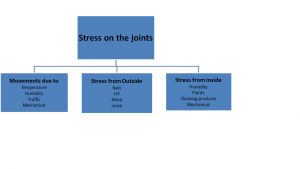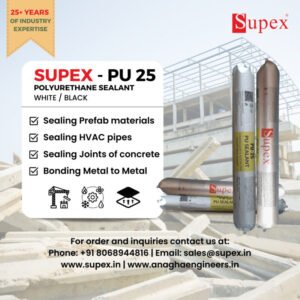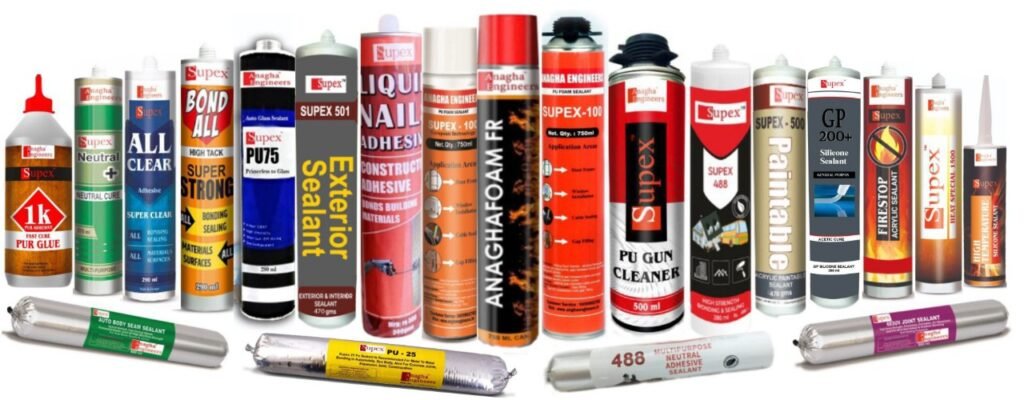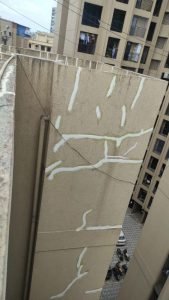Why the need for waterproof gap filler
Waterproof gap filler construction sealants are used regularly in industrial and construction applications. We try and explore why is the gap is created and why do we need to seal it.
Why is the gap created:
Industrial : gaps between flanges due to surface irregularities, Engineering tolerances. When two surface of best machined flanges are mated, metal to metal contact is < 40%.  This is due to crest and troughs on the machined surface not visible to naked eye. These micro gaps become potential leak path in future. Hence such gaps needs to be sealed with a suitable sealant. Anaerobic adhesive is suitable for machined flanges and silicone sealant is better for cast or sheet metal flanges.
This is due to crest and troughs on the machined surface not visible to naked eye. These micro gaps become potential leak path in future. Hence such gaps needs to be sealed with a suitable sealant. Anaerobic adhesive is suitable for machined flanges and silicone sealant is better for cast or sheet metal flanges.
Construction applications
- Gap between window frame and concrete wall: Difference in designed dimensions and manufactured dimensions.
- gap between PU panels: gap is maintained by design for easy installation and maintenance
- Gap between core cut holes and utility pipes, trays, wires etc.
- Gap between Door frame and Concrete wall
Why do we seal these Gaps?
To stop entry of water, atmospheric air, polluting atmospheric gases, sound insulation, electric insulation, water proofing etc.
waterproof gap filler vs traditional gap filling methods.
Traditional Gap filling methods
- White cement
- Mixture of cement + sand slurry
- plaster of Paris
- crack filler powder
- bituminous tape
- Thermocol
Problems with traditional technology
- mixing with water required to prepare the paste
- paste is applied manually, it is cumbersome and time consuming ( high labour cost)
- after drying the sealing material becomes hard and inflexible, it cracks and creates leak paths
- total cost is more than Supex wateproof gap filler sealants
Sealant selection procedure
Factors to be considered while selecting a gap sealer
- Gap between the joints in mm
- Flexibility of the joint depending upon if it is subjected to expansion/ contraction
- Exposure to external environment . Viz : Sunlight – is it UV resistant
- Chemical resistance : exposure to corrosive chemicals, acids, fuels etc
- Temperature to be sustained by the assembly
- Expected life of the joint : sometimes sealant is used temporarily to hold parts together
- Paintibility – can it painted over
- Cost
- Ease of application
Which sealant to use ?
Silicone( Neutral) | Polyurethane | Acrylic | Hybrid MS | |
Gap in mm | ++ | +++ | ++ | +++ |
Flexibility | ++++ | +++ | ++ | ++++ |
Bond strength | +++ | +++ | ++ | ++++ |
Environment/ Weather resistance | Excellent | Good | Good | Excellent |
Cost | ++ | ++ | + | +++ |
Wet Surface/ rains | YES |
Property Required Sealant technology preferred
- High Gap PUF, PU, MS
- High flexibility Silicone, PU, MS
- High Bonding strength MS
- High Weather resistance Silicone, MS
- Lowest cost Acrylic
Gap sealer Foam ( PUF)
Pre-polymer is packed in 750 ml aerosol can with a carrier agent. An adopter ( straw pipe) is screwed onto the tip of can, shaken 15-20 times, inverted upside down and press lever. Liquid foam comes out under pressure and expands upon contact with atmosphere. It expands and cures ( dries) by reacting with the atmospheric moisture into ‘ thermocol’. This cured PU foam provides sound insulation, electrical insulation, water resistance, 100% sealing and bonding, heat insulation.
It is used by various industries including construction, solar, industrial, HVAC and etc.
FR Pu foam is fire retardant too. B1 FR PUF provides 120 minutes of fire retardancy.
Advantages:
- High gap filling capability > 2 inches
- High coverage- low application cost
- Insulates against electricity, Sound, Water, heat- verastile product
waterproof gap filler sealant: Typical Products: Supex 100 PUF Straw grade, B1 FR PUF Anaghafoam FR
Window gap sealer- Interior & Exterior
uPVC Window Installation: Gap between upvc window and concrete wall is filled with Supex waterproof gap filler Sealants.
- Gap upto 5-6 mm: Supex 500 acrylic paintable GP sealant.
- Gap > 5 mm: Apply Supex 100 PU foam to fill maximum gap then apply Supex 500 as a top coat ( approx 2 mm). Max gap is filled with PUF while the top coatof acrylic sealant protects the PUF below and barrier to entry of moisture, environment, rain etc.
Aluminium window / channel installation: Seal gap between granite and aluminium channel or Al. channel and concrete wall with Acrylic General purpose white paintable sealant. Supex 500.
High gap filling : Fill up with PU foam with Supex 100 PUF first, then apply top coat with Supex 500 acrylic paintable sealant.
Regular gap filling: Supex 500 paintable acrlyic sealant.
Gap sealer for External & Internal wall cracks
 External walls– use Supex PU 25, high strength | High gap fill | High elongation | Paintable | Long life Polyurethane sealant
External walls– use Supex PU 25, high strength | High gap fill | High elongation | Paintable | Long life Polyurethane sealant
Advantages of Supex PU 25 over than crack fillers
- ready to use, no mixing with water etc required.
- can be applied with a gun, so application and quantity control is better
- flexible, elongation > 400%
- paintable
- Long life
Internal Walls– Use Supex 501, flexible | paintable | doesn’t crack when exposed to varying climate | cost effective
Advantages of Supex Supex MS 600 vs plaster of paris, white cement, putty
- doesn’t crack with time, remains flexible after drying too
- ready to use , no mixing required
- applied with a gun, better control and easy application
- paintable
- long life- much better than white cement, putty or plaster of paris.
- high bonding strength.
Waterproof Gap Filler
Terrace floor cracks, hairline cracks on beam, column or pillars- Supex MS construction sealant 603UV
Benefits of Supex 603UV over regular/ traditional sealants
- Excellent weather resistance, long life
- high gap filling
- high elongation and high strength too
- paintable
- bonds all building material without primer
Gap Filler for Doors/ Door Sealant
Traditional method: Use white cement to fill the gap between wall and door frame. Application is cumbersome and manual, high labour cost. Yet, with time white cement tends to crack and looses its adhesion strength.
Solution: Apply PU foam spray sealant to fill the gap between wall and frame. High strength, permanent gap fill, no cracks, low cost.
- Supex 100 PUF straw and Gun grade
- Anaghafoam FR- Fire retardant B1 approved
waterproof Gap filler sealants at best price




2 thoughts on “Best Gap filler sealants”
I have chamber made up of puf panels now there is leakage problem from roof… Please help
Request to wahtsapp problem are pics to whatsapp 9833892782